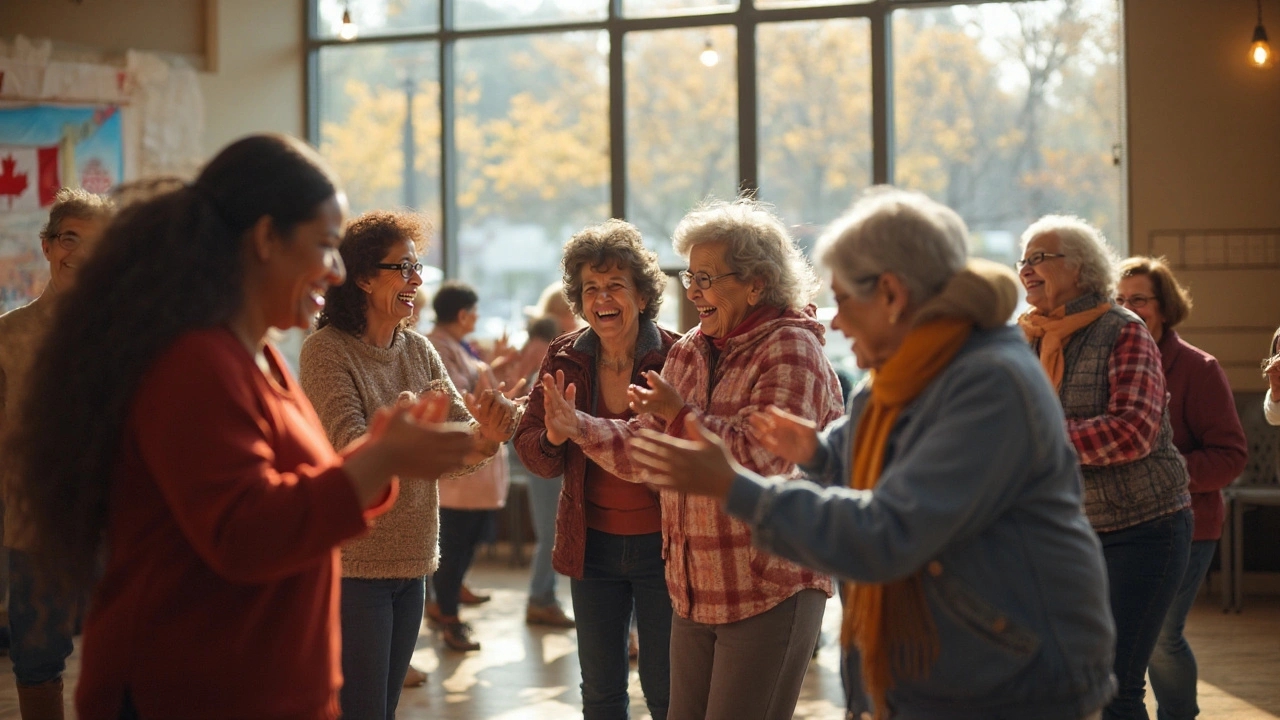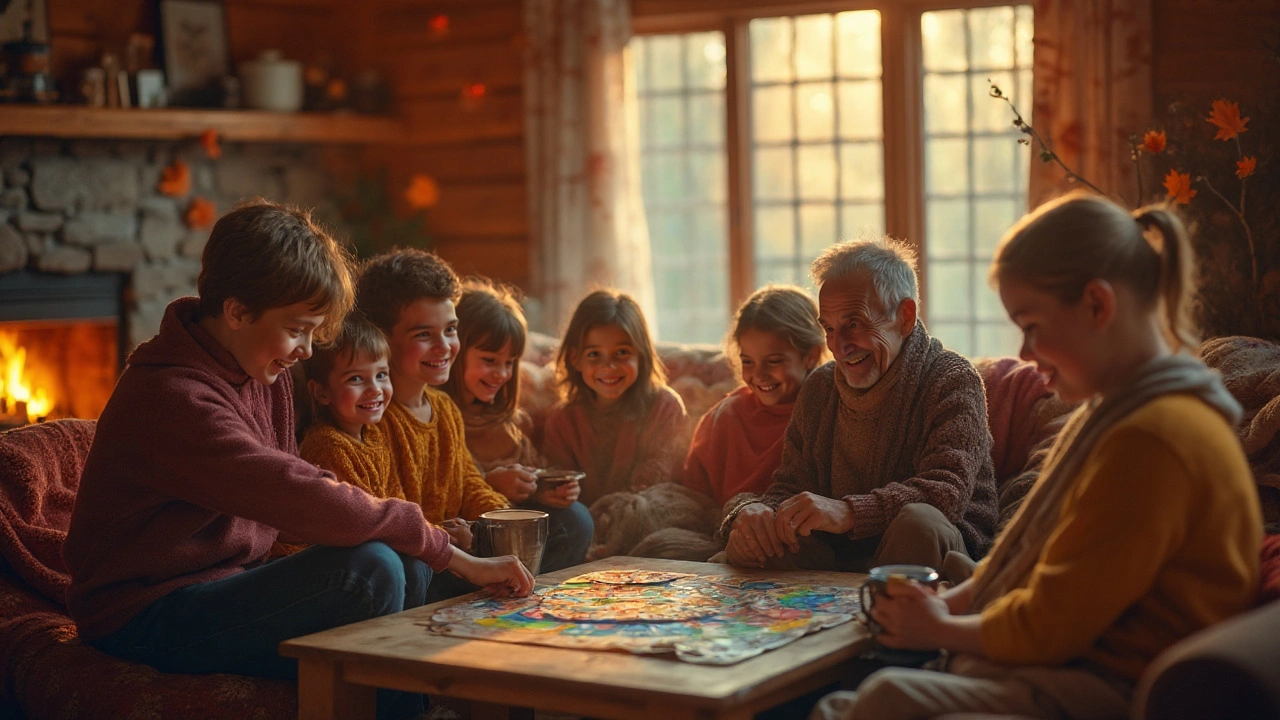Key Takeaways
- Social interaction slows cognitive decline and improves mood in people with Alzheimer’s.
- Different formats-reminiscence groups, music sessions, community outings-have distinct benefits.
- Caregivers play a pivotal role; structured activities reduce burden and foster connection.
- Simple measurement tools (e.g., MMSE, QoL‑AD) can track progress.
- Integrating social engagement early yields the biggest impact on social interaction dementia outcomes.
Social Interaction is a mutual exchange of communication, shared activities, and emotional support between individuals that stimulates neural pathways linked to memory, language, and mood. When harnessed deliberately, it becomes a therapeutic resource for people living with Alzheimer’s type dementia.
Alzheimer’s disease is a progressive neurodegenerative disorder that targets the hippocampus and cortical areas, leading to memory loss, language breakdown, and impaired reasoning. It accounts for roughly 60‑70% of all dementia cases worldwide.
Dementia is a clinical syndrome of cognitive decline severe enough to interfere with daily functioning. While Alzheimer’s is the most common cause, vascular, Lewy‑body, and frontotemporal variants also exist.
Understanding Alzheimer’s Dementia
Alzheimer’s progresses through three stages-early, middle, and late-each marked by distinct challenges. Early‑stage symptoms often include misplaced items and difficulty finding words. Middle stage brings pronounced confusion, agitation, and loss of daily‑living skills. In the late stage, individuals may lose the ability to recognize loved ones and become bedridden.
Neurobiologically, the disease is characterized by amyloid‑beta plaques, tau neurofibrillary tangles, and synaptic loss. These changes reduce neuroplasticity, the brain’s ability to reorganize, which is why external stimulation, such as social engagement, is crucial.
Why Social Interaction Matters
Research from the Alzheimer’s Society (2023) shows that participants who engage in regular social activities experience a 30% slower decline on the Mini‑Mental State Examination (MMSE) compared with isolated peers. The mechanism is twofold: first, interaction activates the limbic system, releasing dopamine and oxytocin that improve mood; second, it challenges language and memory circuits, promoting residual neuroplasticity.
Beyond numbers, families report noticeable improvements in spontaneity, reduced agitation, and better sleep when social routines are introduced. The emotional bond created through shared stories or music also strengthens identity, a core element of person‑centered care.
Key Types of Social Interaction Interventions
While any meaningful contact helps, structured programs deliver measurable benefits. Below is a quick comparison of four evidence‑based approaches.
| Intervention | Primary Focus | Typical Frequency | Key Outcome |
|---|---|---|---|
| Reminiscence Therapy | Memory recall through personal artifacts | Weekly 60‑min sessions | Improved autobiographical memory, reduced depressive symptoms |
| Music Therapy | Emotion regulation via familiar songs | Twice‑weekly 45‑min groups | Lower agitation, better mood, enhanced verbal fluency |
| Community Outings | Social exposure in real‑world settings | Bi‑weekly 2‑hour trips | Increased orientation, higher QoL scores |
| Volunteer Visits | One‑on‑one companionship | Daily 15‑min visits | Reduced loneliness, modest MMSE gain |
Each format taps into different brain networks. For instance, reminiscence therapy leverages the medial temporal lobe, while music therapy engages auditory‑motor circuits, offering a broader stimulation spectrum when combined.

Implementing Social Interaction in Daily Life
Below is a step‑by‑step guide that families and care facilities can adapt.
- Assess preferences. Use the Quality of Life‑Alzheimer’s Disease (QoL‑AD) questionnaire to identify favourite pastimes, music, or topics.
- Set realistic goals. Aim for 3-5 meaningful contacts per week, adjusting intensity as disease progresses.
- Choose formats. Pair a low‑effort activity (e.g., daily chat) with a weekly structured session (e.g., group singing).
- Train facilitators. Caregivers should learn cueing techniques-simple, open‑ended questions, visual prompts, and gentle redirection.
- Monitor outcomes. Record MMSE or MoCA scores quarterly; note changes in agitation (using the Cohen‑Mansfield scale).
- Iterate. If a particular activity loses impact, swap it for a new stimulus to keep the brain challenged.
Role of Caregivers
Caregiver is a person-often a family member or professional-who provides daily assistance and emotional support to someone with a chronic condition. Their involvement directly influences the success of social interventions.
Studies reveal that caregivers who co‑participate in activities report 25% lower perceived stress (Zarit Burden Interview) and observe more cooperative behavior from the person with dementia. Training programs that teach active listening, validation, and non‑verbal cues empower caregivers to become effective social partners.
Measuring Impact
Quantifying benefits helps justify program funding and guides personalization. Common tools include:
- Mini‑Mental State Examination (MMSE): Tracks global cognition; a 2‑point decline over six months is typical without intervention.
- Quality of Life‑Alzheimer’s Disease (QoL‑AD): Patient‑rated scale covering mood, energy, and relationships.
- Cohen‑Mansfield Agitation Inventory (CMAI): Captures frequency of restless or aggressive behaviors.
When paired with activity logs, these metrics reveal patterns-e.g., a 15% drop in CMAI scores after weekly music sessions.
Related Concepts and Next Steps
Social interaction sits within a broader ecosystem of non‑pharmacologic care. Adjacent topics worth exploring include:
- Neuroplasticity: How repeated stimulation reshapes synaptic connections.
- Person‑centered care: Tailoring environments to an individual’s history and preferences.
- Physical activity: Walking groups that combine exercise with social bonding.
- Technology‑assisted engagement: Tablet‑based reminiscence apps and virtual reality tours.
Readers can dive deeper into any of these sub‑topics to build a holistic care plan.

Frequently Asked Questions
Can social interaction replace medication for Alzheimer’s?
No. Social interaction is a complementary strategy. Medicines like cholinesterase inhibitors target neurotransmitter deficits, while social activities address functional and emotional domains. Using both together yields the best outcomes.
How often should a person with moderate Alzheimer’s engage in group activities?
Research suggests 2-3 structured sessions per week, each lasting 45-60 minutes, plus informal daily chats. Frequency can be adjusted based on fatigue levels and personal preference.
What if the person with dementia refuses to join a group?
Respect the refusal and try a different format. One‑on‑one volunteer visits or music played at home often succeed where larger groups feel overwhelming. Gentle prompting and offering a choice can gradually build willingness.
Do virtual reality (VR) experiences count as social interaction?
VR can create shared experiences when used together with a caregiver or a small group, turning a tech tool into a social activity. However, it should supplement, not replace, real‑world human contact.
Is there a risk of overstimulation?
Yes. Overly loud music, crowded rooms, or rapid topic changes can trigger agitation. Start with short, low‑stimulus sessions and watch for signs of fatigue-frowning, wandering, or increased pacing-and adjust accordingly.


andrew bigdick
September 25, 2025 AT 22:51Social chats can actually keep memory gears turning for folks with Alzheimer’s.
Shelby Wright
September 26, 2025 AT 12:45Imagine a room where the tunes are louder than the crisis, where every laugh is a tiny rebellion against the fog of dementia. I love how the article throws in music therapy like it’s a secret weapon, but the real drama is watching someone forget their own name and then suddenly burst into a favorite song. The contrast is wild, and it makes me wonder why we don’t just flood every care home with karaoke nights. Anyway, keep the stories coming, I’m hooked on the emotional roller‑coaster.
Ellen Laird
September 27, 2025 AT 02:38One must aquire a discerning perspective when wading through the sea of well‑meaning advices; the prose here, while well‑intentional, suffers from an overabundance of buzzwordy phrasing that obscures more than it illuminates. The enphasis on "neuroplasticity" feels almost pretentiously placed, as if the writer merely wanted to sprinkle in a trendy term without proper explication. Moreover, there are occasional typographical errors that distract the reader-such as "memmory" instead of "memory"-which unfortunately undermine the scholarly tone the piece aspires to achieve.
rafaat pronoy
September 27, 2025 AT 16:31Cool article! 😊 Social outings seem like a simple win‑win, especially when they’re low‑key and don’t overwhelm the residents. I’ve seen a neighbor’s dad smile after a short stroll to the park, and it reminded me how tiny changes can spark big mood lifts.
Tristan Francis
September 28, 2025 AT 06:25They don’t tell you that the pharma giants are scared of these simple social tricks. If people keep their brains active, why would they need pricey meds? Something’s off, and it’s not just the research.
Keelan Walker
September 28, 2025 AT 20:18Let me tell you why social interaction is more than just a nice‑to‑have perk for folks battling Alzheimer’s 😃. First, when we engage in conversation, we trigger the limbic system, which releases dopamine that lifts mood and improves motivation. Second, sharing stories or singing familiar songs exercises the language centers, keeping neural pathways from going completely silent. Third, regular group activity creates a routine that reduces anxiety, because predictability is comforting for anyone at any stage of cognitive decline. Fourth, these gatherings give caregivers a chance to bond, which lowers their own stress levels and prevents burnout. Fifth, you can actually measure progress: tools like the MMSE or QoL‑AD will show slower decline when these programs are in place. Sixth, the research shows a 30 % slower drop in MMSE scores for participants who attend social events three times a week. Seventh, reminiscence therapy brings back personal identity, a core piece of person‑centered care that’s often lost. Eighth, music therapy taps into auditory‑motor pathways, giving a boost to verbal fluency and a noticeable reduction in agitation. Ninth, community outings provide real‑world orientation, helping patients stay connected to their environment and maintain a sense of place. Tenth, volunteer visits offer one‑on‑one companionship that can cut feelings of loneliness, which is a huge factor in mood disorders. Eleventh, these interventions are cost‑effective, often requiring just a handful of volunteers or simple resources. Twelfth, caregivers who join in feel more competent, which translates into better support for the patient. Thirteenth, the variety of formats-reminiscence, music, outings, volunteer visits-means you can tailor activities to each person’s preferences, maximizing engagement. Fourteenth, technology like tablet‑based reminiscence apps can supplement face‑to‑face interaction, giving a modern twist to classic methods. Fifteenth, by iterating and adjusting the program based on feedback, families can keep the stimulation fresh and avoid overstimulation. All in all, social interaction isn’t just a warm, fuzzy idea; it’s a scientifically backed, multi‑layered approach that can genuinely slow cognitive decline and improve quality of life for those with Alzheimer’s. 🌟
Heather Wilkinson
September 29, 2025 AT 10:11Great roundup! 🌼 I’ve seen music sessions turn a tense afternoon into a calm, smiling gathering. Keep sharing these practical tips, they’re gold for families.
Henry Kim
September 30, 2025 AT 00:05Really appreciate the balanced view here. The step‑by‑step guide feels doable, especially the part about assessing preferences first. It reminds me that even small, consistent chats can make a difference without overwhelming anyone.
Neha Bharti
September 30, 2025 AT 13:58Social connection is a simple yet powerful tool; it respects the person’s history while gently stimulating the mind.
Samantha Patrick
October 1, 2025 AT 03:51Quick tip: when you’re setting up a reminiscence group, use old photo albums and ask familes to bring small trinkets. It helps trigger memories and makes the sessions more interactive. Also, be sure not to overload the schedule-short, regular meet‑ups work better than long, occasional ones. My bad spelling earlier-just wanted to keep it real.
Ryan Wilson
October 1, 2025 AT 17:45Listen, it’s not that social activities are a magic bullet, but pretending they are just to feel good about ourselves is kinda lazy. We need to be honest about the limits-some people just won’t engage no matter how many volunteers show up. Still, it’s better than doing nothing, so let’s keep the standards real.
Bruce Heintz
October 2, 2025 AT 07:38Totally agree with Andrew’s point-simple conversation can be a lifeline. 😊 It’s amazing how a brief chat can spark a memory that’s been tucked away.
richard king
October 2, 2025 AT 21:31While Ryan’s cautionary tone reminds us of the hard limits, we must also remember that every tiny spark of connection is a rebellion against the decay. The drama of a forgotten name resurfacing in a song is nothing short of poetic, and if we ignore those moments, we deny the very humanity we claim to protect.
Richa Punyani
October 3, 2025 AT 11:25Dear Readers, it is with profound respect that I underscore the imperative of integrating structured social engagement at the earliest juncture of Alzheimer’s progression. The empirical evidence, as delineated within, bespeaks a compelling rationale for immediate implementation. I entreat caregivers to heed these findings with the gravitas they merit.
Kris cree9
October 4, 2025 AT 01:18Okay, this whole “social interaction cures everything” hype is overrated. People need meds too, ya know? 🙄
John Babko
October 4, 2025 AT 15:11All this talk about “community outings” and “music therapy” is just a distraction from the real issue!!! The government is pushing these soft‑sell solutions to keep us compliant while they cut funding for proper medical research!!!
Stacy McAlpine
October 5, 2025 AT 05:05Interesting take! I think it’s crucial to consider cultural preferences when designing social programs for dementia patients; what works in one community may not resonate in another.
Roger Perez
October 5, 2025 AT 18:58Love the comprehensive guide! 😊 It gives families a solid roadmap to follow and makes the whole process feel less overwhelming.